
Carnation: planting, care, sowing tips
Contents
Dianthus in a nutshell
- Whether perennial or annual, cilium is a floriferous, highly fragrant plant
- Its single or double flowers, in a wide range of colours, exude an intense clove scent
- An emblematic plant of dry and natural gardens, it blooms in both border beds and pots, from spring to late summer
- It is the king of cut flowers and wildflower bouquets
- Easy and undemanding, it thrives in full sun in all well-drained soils, even calcareous ones
A word from our expert
With its precious flowers and sweet, spicy fragrance, whether it be the Florist’s Carnation or Chabaud, Sweet William, Poet’s Carnation, or the Rock Carnation, the Dianthus is an essential flower in traditional and wild gardens. This timeless emblem of our grandmothers’ gardens, with its simple beauty, has a place in every garden. It graces naturalistic gardens as well as vegetable plots for its cut flowers, and summer flower beds like lush mixed borders. Easy to grow, resilient, and versatile, its bucolic charm lightens perennial borders. Dwarf varieties bloom in sunny rockeries or slopes and in window boxes, bringing poetry, mystery, and lightness. Unicoloured or bicoloured, subtle or vibrant, flowering cushions or bushy perennials, Dianthus belongs to a very heterogeneous family with diverse colours and sizes, offering limitless choices for gardeners. Ruby red, lavender pink, pure white, or primrose yellow, its simple or very double flowers, resembling frilled pompons or delicate inflorescences, bloom from spring to late summer, sometimes continuously, creating charming country-style bouquets.
From the Poet’s Carnation to the Chinese Carnation, passing through the Sweet William and the Carthusian Carnation, discover among our collections the different species of carnations we offer.
Botany
“`html
[plant_sheet latin_name=”Latin name(s): Dianthus” family=”Family: Caryophyllaceae” common_names=”Common name(s): Carnation” flowering=”Flowering: from April-May until autumn” height=”Height: 20 to 80 cm” exposure=”Exposure: Sun” soil=”Soil: Stony, Calcareous, neutral” hardiness=”Hardiness: -15°C for tall species, down to -20°C for dwarf carnations” bgcolor=”#bf7e8c” alignment=”left” /]
Originating from the mountains and dry meadows of Asia and Europe, the carnation or Dianthus, meaning “Flower of God”, belongs to the very large family of Caryophyllaceae. Some species, such as the Chartreuse carnation, are found naturally in France, on calcareous lawns, rocky slopes, and in clear forests. Although the carnation bears a vague resemblance to the marigold (Tagetes), they do not belong to the same botanical family. The genus Dianthus comprises around 300 species of perennials, including florist’s carnations, both remontant and non-remontant, old and modern pinks (Dianthus plumarius), rock carnations, annual varieties like the China pink (Dianthus chinensis), and biennials like the famous Dianthus barbatus or poet’s carnation. Not to mention the thousands of horticultural varieties obtained through successive hybridizations! This family encompasses both tall and short species, offering a wide variety of sizes, shapes, and colours.
All develop from a branching, sometimes woody, stump that spreads over the years through its underground buds to form dense, highly floriferous clumps, with each node branching out.
If the growth of the carnation is relatively rapid, its longevity varies depending on the nature of the soil; in poor, well-drained soils, it can live for several decades, but only a few years in rich soils. However, it can persist for a long time in a garden.
Indeed, some, like the poet’s carnation, self-seed spontaneously when the faded flowers are not removed. Propagation by cuttings allows for the production of new plants each year and ensures the continuation of this short-lived perennial!
The habit of Dianthus varies according to the species: airy and rounded, compact for some, cushion-like or tall stems bending under the weight of flowers for others. The largest carnations can reach nearly a metre, while intermediate species stand 30 to 60 cm tall with similar spread, and dwarf carnations will not exceed 10 to 20 cm in height.
The stems are very short and dense in spreading or tufted species, but longer and stiffer or thinner, sometimes requiring discreet staking, in border perennials. The leaves (those of dwarf carnations measure 1 to 5 cm long, while others range from 5 to 13 cm) of all species and cultivars of Dianthus are opposite, lanceolate or linear, mostly pointed, and often grey-blue or grey-green. The Dianthus barbatus displays more vigorous foliage, ranging from medium green to dark bronze. The silvery and very fine foliage of many Dianthus adds extra charm to the plant. Evergreen in perennials, it remains attractive even in winter and forms beautiful bushy clumps from which, in fine weather, the flowers emerge, the true attraction of this herbaceous perennial.
Whether perennial or annual, from April to September depending on the varieties, or even until frost, the Dianthus offers a generous and generally fragrant flowering.
The carnation can be uniflorous or pluriflore. The floral stems rise from 20 cm to 1 m and bear large flower buds that open into small solitary flowers (1 to 13 cm in diameter) or tightly clustered together, in umbels or terminal cymes that can reach up to 15 cm in diameter. In Dianthus barbatus, they form dense bouquets of small simple carnations. Each carnation flower features a tubular base that envelops the calyx. The shape of the flower is highly variable; it can be single with 5 petals, semi-double, or very double with 50 to 60 petals and more or less frilled, resembling a lace pom-pom. The petals can be rounded, crinkled, bearded, delicately carved, or very fringed. The flowers of Dianthus superbus or the Superb Carnation are characterised by five petals cut into narrow, uneven strips that give a tousled appearance to the inflorescences. Colours range from pure white to ruby red, cream to yellow, and all shades of pink, from pearly to deep violet. Sometimes bicoloured, the flowers offer a more or less contrasting appearance. Carnations are distinguished by the colours of their flowers: solid, bicoloured, edged with a fine border on each petal, fanciful with streaks or speckles contrasting against the background colour, and shaded, with the petal claws recalling the colour of the edges.
Old-fashioned pinks (Dianthus plumarius) have a relatively short flowering period. They bloom in June or around mid-summer for two to three weeks. Some, like florist’s carnations and modern pinks, offer a much longer remontant flowering that lasts all summer and part of autumn, occurring in two or three waves. Regular and moderate deadheading will encourage new blooms.
Perfect as cut flowers, carnations have excellent vase life and make very pretty, fragrant summer bouquets that last nearly two weeks.
The flowers exude a delightful and powerful spicy fragrance reminiscent of cloves. Melliferous and very airy, they are highly visited by foraging insects.
After flowering, they give way to capsules containing numerous seeds.

Dianthus Barbatus – D. plumarius – D. superbus – D. ‘Pop Star’
Beneath its precious flower appearance, the carnation combines vigour and undemanding nature. It is a robust, low-maintenance plant. While some are more tender and frost-sensitive, the carnation is generally very hardy, sometimes tolerating temperatures below -15°C for dwarf varieties. Most carnations are compact and vigorous and grow well throughout France, blooming tirelessly from spring until frost, indifferent to heavy rain as well as drought.
The carnation is remarkably floriferous as long as it is planted in full sun, in an open location. Easy to cultivate, it is an undemanding plant that loves calcareous and dry soils but also does well in poor soils that are neutral or even acidic, provided they are well-drained. It thrives in stony, sandy soil. It does not fear summer drought but dislikes humidity, both in summer and winter. In rich soil, it can be more vigorous.
Essential in naturalistic gardens, the carnation is a versatile flower that finds its place everywhere. It brings colour, relief, and lightness to beds, rockeries, mixed borders, and flowering pots. It also has its place in the vegetable garden in the cutting flower corner. While Dianthus can be grown in isolation, it is preferably planted in groups at the edge or in the middle of sunny beds, paired with grasses or other vigorously growing perennials. In borders, plant the tall carnations en masse to create beautiful colourful scenes with Nepetas, Scabious, Coreopsis, dwarf Gaillardias, Cleomes, or ornamental Tobacco. It mixes spontaneously with the grey-green foliage of Euphorbias and Wormwoods. Its graceful silhouette lightens the mass of heavier perennials: it adds lightness next to large-flowered summer plants like Dahlias and Echinaceas. The perennial species form an evergreen bush where fine grey-green leaves are attractive all year round. The low varieties are perfect for raised beds, in dry rockeries, on well-drained slopes, or between the stones of a wall where they form low-maintenance flowering cushions. They adapt very well to pot cultivation or in troughs, in the sun on the terrace or balcony, paired with moss Phlox, Avens, or Yarrow, Asters, Iberis, Aubrietas, or Helianthemums. Choose a passageway location, near an entrance, for example, to fully enjoy the sweet fragrance of certain varieties.
“`
Read also
Carnation: planting, care, sowing tipsMain species and varieties
The genus Dianthus comprises around 300 species of perennial evergreen plants, annuals, and biennials, not to mention the tens of thousands of horticultural varieties resulting from successive hybridizations. This family includes both tall and dwarf species, offering a wide variety of sizes, shapes, and colours. The repeat flowering species are distinguished from the non-repeat flowering carnations.
- Pinks or feathered carnations (Dianthus plumarius): both repeat flowering and non-repeat flowering, they are well-suited for pots, rockeries, and borders. They are more compact than florist’s carnations and bear more branched stems with large, often highly fragrant double flowers. They are perennial, evergreen, and hardy. The old type offers a brief flowering that begins in June and lasts for two to three weeks. The flowering of modern pinks often starts in May and ends in September, lasting longer and occurring in two or three successive waves.
- Charterhouse pink (Dianthus carthusianorum): with its long, thin stems, it displays a very original habit with its linear, evergreen foliage resembling grass. Its simple, dentate flowers appear in rounded, flattened clusters of dark pink to red, sometimes white with a black calyx.
- Grenoble pink or Pentecost pink (Dianthus gratianopolitanus): originating from a montane species, it combines robustness and undemanding nature. It is characterized by its compact, spreading habit with semi-evergreen blue-grey foliage. Very floriferous in May and June, the plant is covered with small, highly fragrant simple or double pink to violet flowers. This pink grows rapidly and is particularly resistant to heat and humidity. Its adult height does not exceed 20 cm, with a spread of 40 cm.
- Dianthus deltoides, “cushion pink” or “heath pink”: Perfect for rockeries and border edges, it forms a dense dark green, sometimes bluish carpet covered with small fragrant flowers with fringed petals in red, white, or pink, sometimes with a darker eye.
- Sand pink (Dianthus arenarius): this botanical species forms a discreet cushion about 30 cm high, covered with small, slightly fragrant white fringed flowers on fine green foliage. Very floriferous until September.
Annuals and biennials:
- Sweet William (Dianthus barbatus): Not very perennial, with a short lifespan, it is grown as an annual or biennial. It is among the tallest, reaching 70 cm in height. It forms branched bushes with well-defined leaves that bear dense clusters of small, flat, simple carnations, sometimes bicoloured with finely serrated petals in pink, red, or white, fragrant with a pale eye. Some new hybrid varieties like the ‘Jolt’ series gather cultivars selected for their vigorous growth, bright colours, heat and cold tolerance, and ability to flower tirelessly from spring until frost.
- Florist’s carnation or wild carnation (Dianthus caryophyllus): also known as “clove pink” or “Chabaud pink”, this short-lived perennial grown as a biennial is mainly used as a cut flower. It forms clumps with green foliage on which very fragrant double flowers in purple, salmon, white, or red appear from May to June for non-repeat flowering varieties, and from June until frost for repeat flowering varieties.
- China pink (Dianthus chinensis): this tender short-lived plant bears numerous lightly fragrant dark purple or reddish flowers, often maculate or striated with white, which bloom continuously from summer to autumn.
 Dianthus gratianopolitanus – D. plumarius – D. deltoides – D. barbatus – D. arenarius
Dianthus gratianopolitanus – D. plumarius – D. deltoides – D. barbatus – D. arenarius
Our favourites
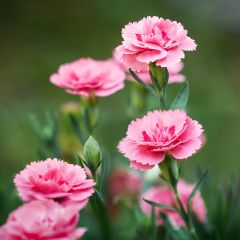
Dianthus plumarius Doris
- Flowering time June to October
- Height at maturity 25 cm
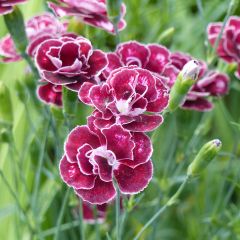
Dianthus allwoodii Romeo
- Flowering time June to October
- Height at maturity 40 cm
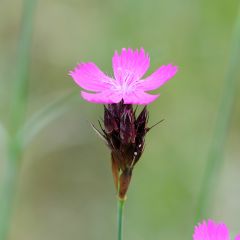
Dianthus carthusianorum
- Flowering time August, September
- Height at maturity 40 cm
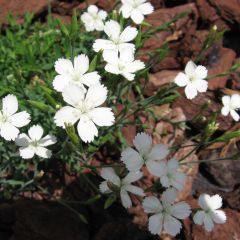
Dianthus deltoides Albiflorus
- Flowering time June to August
- Height at maturity 15 cm
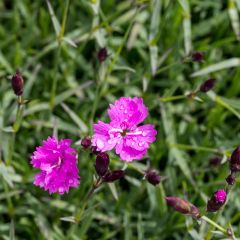
Dianthus gratianopolitanus Badenia
- Flowering time June to November
- Height at maturity 15 cm
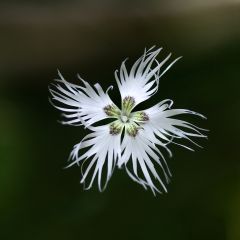
Dianthus arenarius
- Flowering time August to October
- Height at maturity 25 cm
Are you looking for a highly fragrant carnation? Discover our advice sheet: “Carnations: which are the most fragrant”
Discover other Dianthus - Pinks
View all →Available in 0 sizes
Available in 2 sizes
Available in 2 sizes
Available in 2 sizes
Available in 1 sizes
Available in 2 sizes
Available in 2 sizes
Available in 1 sizes
Available in 2 sizes
Available in 1 sizes
Planting
When to Plant Dianthus?
Carnations are best planted in spring from March to April or in autumn from September to October, avoiding periods of frost and drought.
Where to Plant Dianthus?
Very easy to grow, it thrives almost everywhere in France and even adapts to coastal areas. With good hardiness (down to -15°C), it withstands frost and copes well with summer drought. It prefers a sunny or very lightly shaded and open position. While it enjoys alkaline conditions, it tolerates all well-drained soils. It is averse to clay soils that retain water, favouring permeable and stony soils, from dry to moist. In waterlogged or clayey soil, it would be more vulnerable to rust or certain viruses that could be fatal.
This versatile plant flourishes in all kinds of bright, warm locations. Dianthus can be grown alone but is best planted in groups at the edge or in the middle of sunny borders, paired with small grasses and other vigorous perennials to add colourful touches: Campanulas, Nepetas, Veronicas, dwarf Asters, Alyssums, Love-in-a-Mist, moss Phlox, Achilleas, or even Helianthemums. In the vegetable garden, it also has its place in the flower corner for cut flower arrangements. The low varieties are perfect for raised beds, in dry rockeries, on well-drained slopes, or between the stones of a wall where they form low-maintenance flowering cushions. They also adapt very well to pot cultivation, on the terrace or balcony.
How to Plant?
Easy to grow, once well established, these perennial and hardy plants are trouble-free. The secret? The soil must be light, cool during summer, and especially well-drained (excess water in summer or winter would be fatal).
- Soak the pots in water before planting
- Loosen the soil, working it well.
- Dig a hole twice the volume of the pot
- In heavy soil, incorporate gravel to improve drainage
- Plant in a mixture of potting soil and garden soil, ensuring not to bury the basal leaves. Plant elevated in humid regions.
- Count 6-7 pots per m²
- Space the plants 25 cm apart when planting
- Fill in with soil
- Lightly firm down
- Water a little at first to encourage rooting
Pot Cultivation of Carnations
- Place a layer of clay balls or gravel at the bottom of the pot to prevent standing water
- Plant in a well-draining mixture of potting soil, garden soil, and gravel
- Position in sunlight
- Avoid leaving water in the saucers: Dianthus hate having their roots in water
- Apply a balanced fertiliser in spring
Read also
Propagating and sowing carnationsMaintenance and Care
Very resistant to diseases, once well established, the carnation requires little care and proves to be a trouble-free perennial as long as the soil remains perfectly drained.
- Remove flowers as they fade to encourage the appearance of new blooms. Pinch back older plants more moderately.
- Florist’s carnations and sweet williams may require slight staking to support the flower stems.
- Lightly trim the clump after summer flowering to encourage regrowth in September for repeat flowering varieties.
- A light clean-up or trimming of some of the dried foliage with shears close to the ground at the end of summer is sufficient to maintain a dense habit and ensure flowering the following season.
- Water in case of prolonged drought: it tolerates periods of high heat very well.
- Take cuttings or perform layering to ensure the plant’s longevity.
Multiplication
The division of clumps is a very delicate operation. We do not recommend it, especially since carnations can be easily sown and propagated by cuttings.
By Sowing
This perennial is very easy to grow from seed. Seeds germinate in 1 to 3 months. Depending on the species, sowing occurs at different times of the year. Annual species are sown in February-March. Dwarf species are sown from October to March under frames, while biennial and perennial species are sown in situ in autumn or under cover in March-April.
- Sow in trays on the surface of light, moist compost
- Do not cover the seeds as they need light to germinate
- Keep at a temperature between 15-20°C and in light
- Maintain this substrate moist but not waterlogged; germination usually takes 7 to 30 days.
- Transplant the young plants into pots when the seedlings have two or three leaves
- Transplant in May into the open ground when the root system is sufficiently developed and the risk of frost has passed.
By Cutting
Propagation by cuttings is an easy method to multiply all carnations. The success rate is very good.
- In summer, take a non-flowering stem a few centimetres below a node. Remove the leaves from the base.
- Plant two-thirds of the stem in a pot with a light substrate made of garden soil, sand, and compost.
- Regularly moisten the cuttings and keep them sheltered from frost
- After about 2 months, repot the cuttings into pots
- Plant out the following spring, in April-May when all risk of frost has passed.
Learn more in our advice sheets: “Propagate and Sow Carnations”; and also read our tutorial: How to Propagate Carnations?
Associate
Carnations are versatile plants that find their place everywhere. They bloom in borders, sunny pathways, and English mixed-borders. In the vegetable garden, they belong in the cutting flower corner. Their graceful and light silhouette helps to lighten the mass of heavier perennials.
In borders, plant the tall carnations in groups to create beautiful colourful scenes with Catmints, Scabious, Coreopsis, dwarf Gaillardes, Cleomes, or ornamental Tobaccos. The silver and evergreen foliage of Dianthus blends spontaneously with the grey-green foliage of Euphorbias and Wormwoods, adding lightness next to summer bloomers with large flowers like Dahlias and Echinaceas.
The low varieties are perfect for raised beds, dry rockeries, well-drained slopes, or between the stones of a wall where they form low-maintenance flowering cushions. They adapt very well to pot or trough cultivation, in full sun on the terrace or balcony, paired with Moss Phlox, Avens or Yarrow, Asters, Iberis, Aubrieta, or Helianthemums. Choose a spot near a pathway, such as by an entrance, to fully enjoy the sweet fragrance of certain varieties.
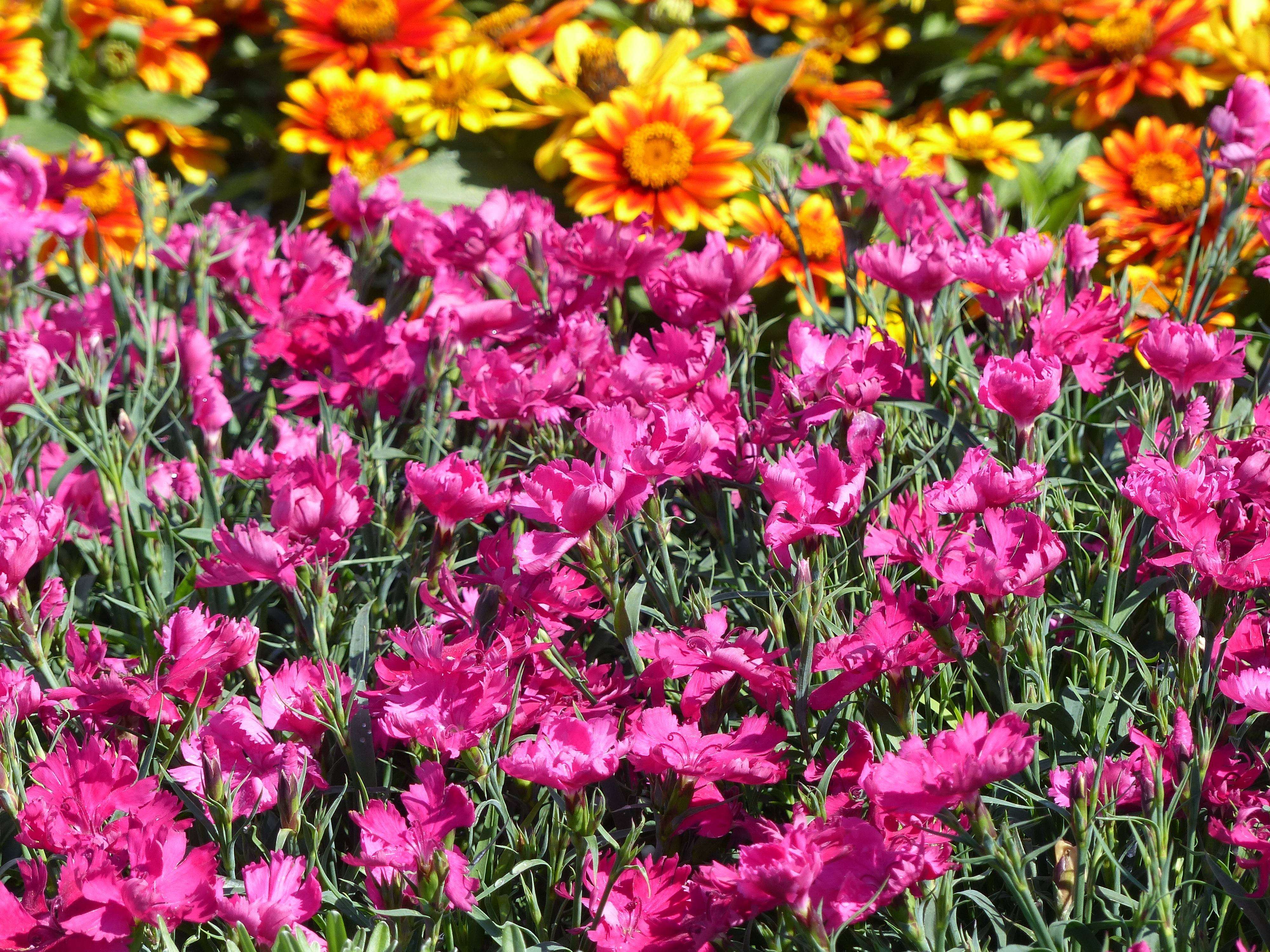
And for even more inspiration, discover our advice sheet: “Carnations – 6 Pairing Ideas”
Useful resources
Discover:
- Our wide range of carnations: it includes the best varieties
- Our tutorial: How to dry carnations
- Our advice sheet: Growing a carnation in a pot and 6 carnations to grow in pots
- Our advice sheet: How to plant the carnation properly?
- Our advice sheets: The 5 most beautiful pink carnations, The 5 most beautiful red carnations, The 5 most beautiful white carnations
- Our advice sheet: 7 carnations for dry rockeries
- Our advice sheet: Choosing a carnation
- Our advice sheet: 10 carnations to plant at the edge of a flower bed
- Perfumer’s plants
- Also read our advice sheet on The best long-lasting flowers and foliage for your bouquets
- Subscribe!
- Contents
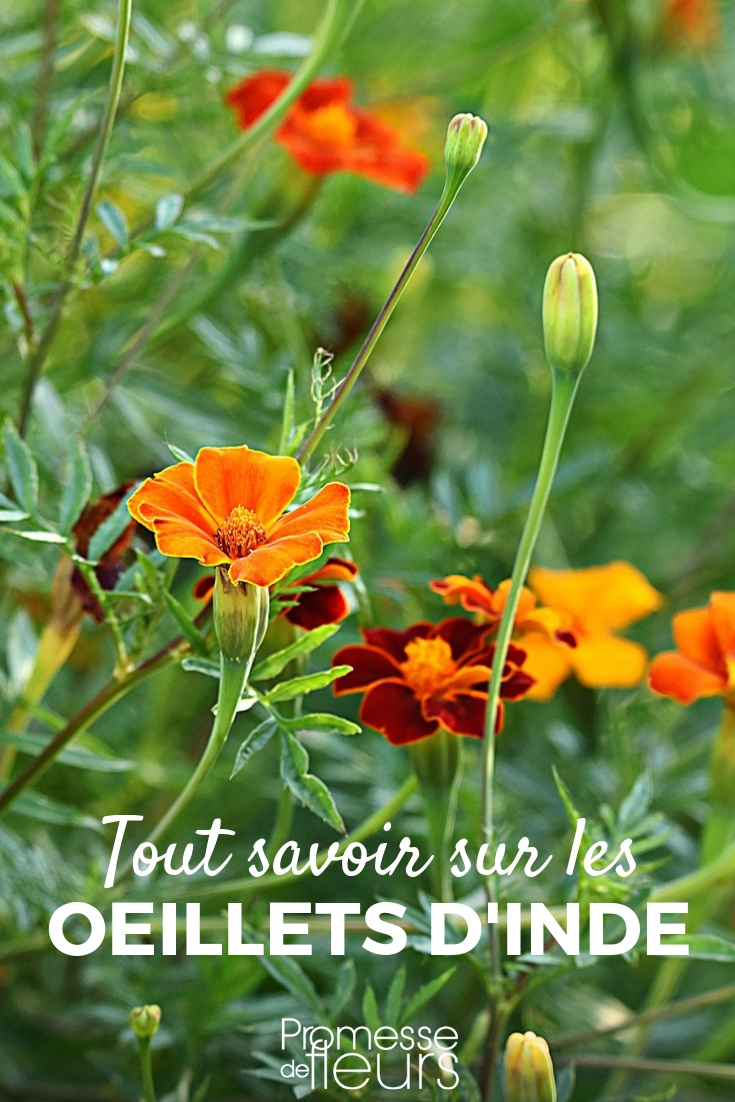































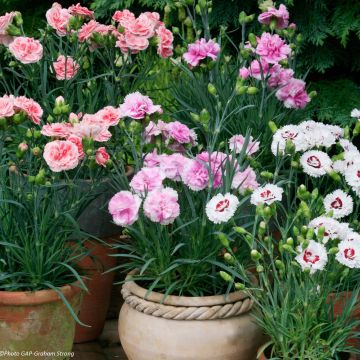


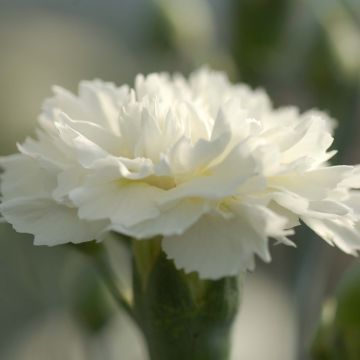
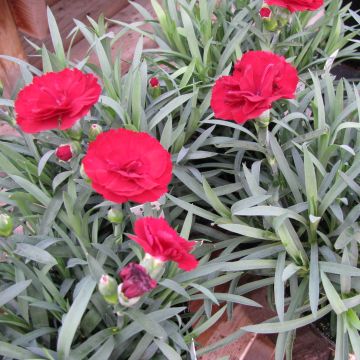
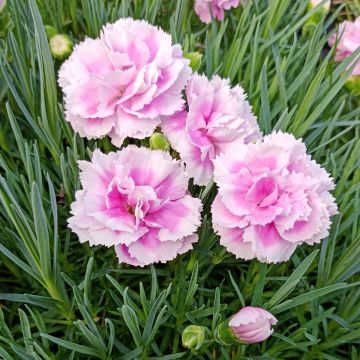
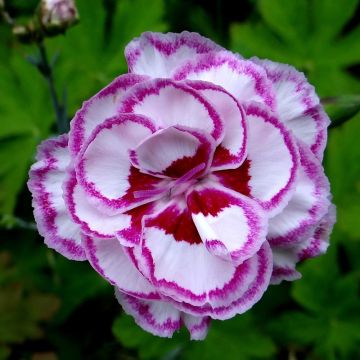

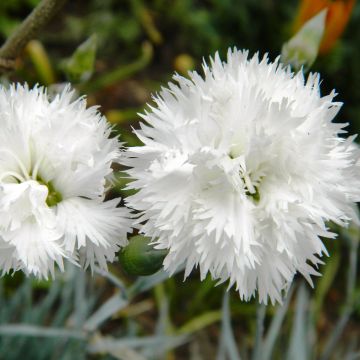
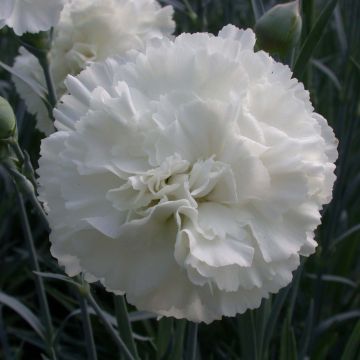
Comments